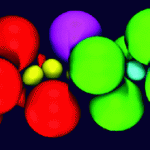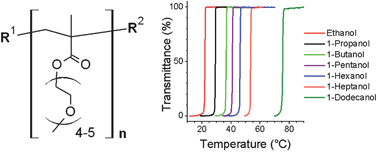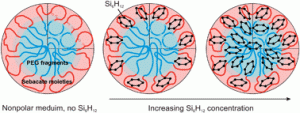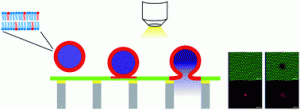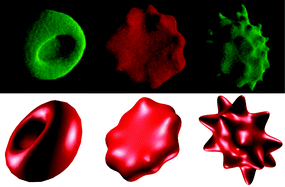Chakrabarti and Wales draw inspiration from DNA to perform theoretical studies on a model supramolecular helix system. They demonstrate the inversion of helix handedness results from cooperative rotation of the two segments of opposite handedness in opposite directions. A mechanical motion rarely observed in molecular machines.
Archive for the ‘Hot Article’ Category
Hot Article: UCST-type phase transitions for stimulus responsive polymers
Stimulus responsive soft matter with an upper critical solution temperature (UCST), the temperature at which a mixture is miscible in all proportions, has potential uses in drug delivery and separation technology.
The authors of this hot article study one of the few known polymers which exhibit Flory-Huggins UCST-behaviour, poly(oligo(ethylene glycol) methacrylate) (POEGMA), in aliphatic alcohols.
Three hot articles on polymer single chain nanoparticles, 3-D patterning of porous materials, and deformation induced pattern transformations.
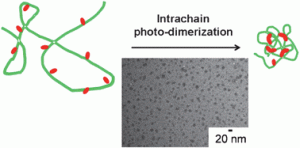 Preparation of polymer single chain nanoparticles using intramolecular photodimerization of coumarin. An easy method for preparing polymer single chain nanoparticles has been developed by scientists at Université de Sherbrooke, Canada. The method uses the photodimerization of coumarin groups located on the same chain to obtain the intrachain cross-linking required for chain collapse in solution. This approach be used as a nanoreactor for the synthesis of AuNPs and provides a way to optically control the kinetics of AuNP formation. (Soft Matter, 2011, Advance Article DOI:10.1039/C0SM01383H)
Preparation of polymer single chain nanoparticles using intramolecular photodimerization of coumarin. An easy method for preparing polymer single chain nanoparticles has been developed by scientists at Université de Sherbrooke, Canada. The method uses the photodimerization of coumarin groups located on the same chain to obtain the intrachain cross-linking required for chain collapse in solution. This approach be used as a nanoreactor for the synthesis of AuNPs and provides a way to optically control the kinetics of AuNP formation. (Soft Matter, 2011, Advance Article DOI:10.1039/C0SM01383H)
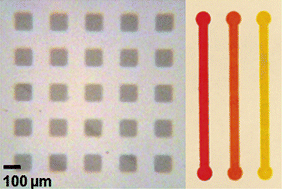 Three-dimensional patterning of porous materials using vapor phase polymerization. Scientists at University of Southern California, USA, have demonstrated that solventless initiated chemical vapor deposition can be used for three-dimensional patterning of porous substrates. They demonstrated the utility of their patterning process by fabricating three-dimensional hydrophilic and hydrophobic regions into the chromatography paper for use as paper-based microfluidic devices. The patterning process represents an environmentally friendly method to pattern three-dimensional materials since no organic solvents are used during the polymerization process or patterning step the team claim. (Soft Matter, 2011, Advance Article DOI:10.1039/C0SM01214A)
Three-dimensional patterning of porous materials using vapor phase polymerization. Scientists at University of Southern California, USA, have demonstrated that solventless initiated chemical vapor deposition can be used for three-dimensional patterning of porous substrates. They demonstrated the utility of their patterning process by fabricating three-dimensional hydrophilic and hydrophobic regions into the chromatography paper for use as paper-based microfluidic devices. The patterning process represents an environmentally friendly method to pattern three-dimensional materials since no organic solvents are used during the polymerization process or patterning step the team claim. (Soft Matter, 2011, Advance Article DOI:10.1039/C0SM01214A)
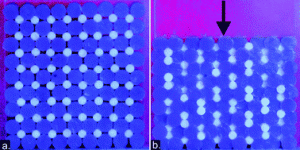 Deformation induced pattern transformation in a soft granular crystal. A novel pattern transformation when regular arrays of macroscopic particles are subjected to uniaxial compression has been discovered by a team of scientists based in USA, UK, and The Netherlands. The team used a combined experimental and numerical study to uncover the transformation. They say the 2D granular crystals studied in the current study combined with pattern transformation could find interesting applications in tunable phononic devices and that the same mechanism could offer colour tuning by mechanical loading and other novel applications in photonic crystals. (Soft Matter, 2011, Advance Article DOI:10.1039/C0SM01408G)
Deformation induced pattern transformation in a soft granular crystal. A novel pattern transformation when regular arrays of macroscopic particles are subjected to uniaxial compression has been discovered by a team of scientists based in USA, UK, and The Netherlands. The team used a combined experimental and numerical study to uncover the transformation. They say the 2D granular crystals studied in the current study combined with pattern transformation could find interesting applications in tunable phononic devices and that the same mechanism could offer colour tuning by mechanical loading and other novel applications in photonic crystals. (Soft Matter, 2011, Advance Article DOI:10.1039/C0SM01408G)
Hot Article on emerging area: biomaterials that mimic and exploit protein motion
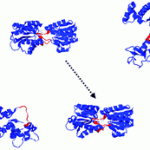 An excellent overview of an emerging strategy for synthesising hydrogels with more specific bio-responsiveness. Known protein motions are used as building blocks for synthetic dynamic materials, exploiting the conformational changes in proteins in response to specific biochemical triggers. Potential applications include drug delivery and bio-sensing.
An excellent overview of an emerging strategy for synthesising hydrogels with more specific bio-responsiveness. Known protein motions are used as building blocks for synthetic dynamic materials, exploiting the conformational changes in proteins in response to specific biochemical triggers. Potential applications include drug delivery and bio-sensing.
Two Hot Articles: ‘Nanofluidic networks created and controlled by light’ and ‘Cluster theory of Janus particles’
Nanofluidic networks created and controlled by light. Nanofluidic networks have been fabricated in an oil-in-water emulsion by a team from the UK. In this hot paper, the authors demonstrate the principles required to create networks of micron-sized reactors connected by conduits less than 100 nm in diameter and to transfer reagents between them, entirely with lasers. These networks form a platform for chemistry on the attolitre scale and could open a path to controlled chemical reactions between single molecules the team claim. (Soft Matter, 2011, DOI:10.1039/C0SM01183E Advance Article)

Cluster theory of Janus particles. A cluster theory for the vapor of Janus fluid has been constructed by a team from Italy and South Africa. The team say that main idea behind the present approach is to consider the vapor phase as formed by clusters, containing an increasing number of particles, that are weakly interacting among each other so that simple fluid models—such as ideal gas or hard spheres—can be used to mimick their physical properties. (Soft Matter, 2011, DOI:10.1039/C0SM00995D Advance Article)
Read both articles for free until 18th March.
Hot Article: Cyclohexasilane-Liquid precursor for electronics
Researchers have overcome solubility issues with cyclohexasilane by encapsulating it in copolymer micelles. The silane exhibits a stable host-guest interaction with the amphiphilic invertible polymers. Liquid precursors, such as cyclohexasilane are important for manufacturing electronic devices, similar to the ink component in inkjet printing.
Hot Article: Lipid Membrane Fushion
A novel fusion assay based on pore-spanning membranes has overcome the drawbacks of black lipid- and solid supported-membranes. This assay was able to monitor the calcium ion mediated fusion of lipid membranes, an important process in biology.
Scanning ion conductance microscopy investigated the change in morphology of the pore membrane after coating of the pore holes by the lipids.
Read the article for free here until Marth 11.
Ines Höfer and Claudia Steinem, Soft Matter, 2011, (Advance Article), DOI: 10.1039/C0SM01429J, Communication
Hot Article: How do mechanical forces shape cells and their organelles?
Researchers show that the spherical harmonics parameterization (SHP) method reliably calculates vesicle and cell morphology. Most importantly, SHP calculated the shape of red blood cells (RBC), reproducing the slightly out-of-plane spicules observed experimentally for echinocytes (crenated RBCs).
A trio of Soft Matter Hot Articles
 Self-assembly of cellulose nanofibrils by genetically engineered fusion proteins. The team led by Markus Ben Linder describe how genetic engineering is used to design proteins that have “smart” functionalities that allow directed self-assembly of cellulose nanofibrils for the control of nanostructures in soft materials.
Self-assembly of cellulose nanofibrils by genetically engineered fusion proteins. The team led by Markus Ben Linder describe how genetic engineering is used to design proteins that have “smart” functionalities that allow directed self-assembly of cellulose nanofibrils for the control of nanostructures in soft materials.
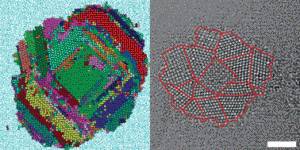 Nucleation of colloidal crystals on configurable seed structures. This hot paper shows the topology of the initial hard sphere nucleus determines the morphology of the crystal. The team led by A. van Blaaderen claim that the reported results explain the complex crystal morphologies observed in experiments on hard spheres.
Nucleation of colloidal crystals on configurable seed structures. This hot paper shows the topology of the initial hard sphere nucleus determines the morphology of the crystal. The team led by A. van Blaaderen claim that the reported results explain the complex crystal morphologies observed in experiments on hard spheres.
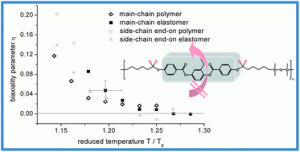 Molecular dynamics and biaxiality of nematic polymers and elastomers. In this paper the authors study the origins of phase biaxiality in nematic polymers and elastomers to gain insight into the relation of molecular dynamics and biaxiality. The team report that broad biaxial nematic phases were found for liquid crystalline polymers in all conventional attachment geometries.
Molecular dynamics and biaxiality of nematic polymers and elastomers. In this paper the authors study the origins of phase biaxiality in nematic polymers and elastomers to gain insight into the relation of molecular dynamics and biaxiality. The team report that broad biaxial nematic phases were found for liquid crystalline polymers in all conventional attachment geometries.
Read all of the papers for free until the 11th March.
Hot Article: Coupled oscillations in a 1D emulsion of Belousov–Zhabotinsky droplets
Coupled oscillations in a 1D emulsion of Belousov–Zhabotinsky droplets. This article by Jorge Delgado, Ning Li, Marcin Leda, Hector O. González-Ochoa, Seth Fraden and Irving R. Epstein reports the use of a programmable illumination source to control the boundary and initial conditions of arrays of small numbers of non-linear, oscillating, micron-sized Belousov–Zhabotinsky droplets. The team say that in these small collections of droplets, transient patterns decay rapidly and they observe several more complex attractors, including ones in which some adjacent droplets are in-phase. (Soft Matter, 2011, DOI: 10.1039/C0SM01240H, Advance Article)
Interested to know more? Why not read the full article for free:


